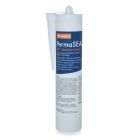Help & Advice Articles, Videos and How-to-Guides
Filter Articles
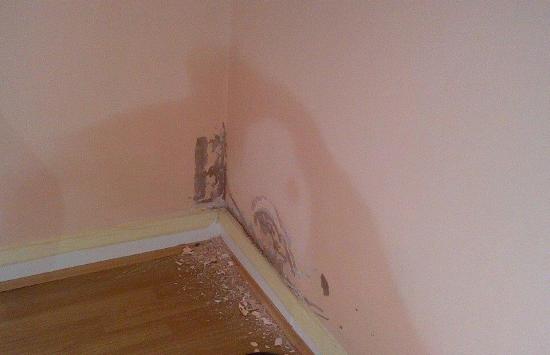
How to Treat Rising Damp
Rising damp is one of most talked about and controversial types of damp. Putting aside the debates for a moment, if you think you might have an issue with rising damp you are in the right place. This How To guide takes you through identifying rising damp, the causes and how to effectively deal with it. A large part of this guide is given over to correctly identifying rising damp in your home, telling it apart from much more common damp issues. We also bust some myths around rising damp and its treatment.
What is Rising Damp?
Rising damp is a relatively rare form of damp that affects the walls of buildings. It occurs when moisture from the ground travels up through the walls by capillary action. This means that ground water is effectively sucked up through tiny tubes in the bricks, like a series of straws. This water contains salts that also travel up through the wall.
Around the affected wall, you get other porous building materials such as plasterwork and the timber found in the floor boards, joists and skirtings. These materials will also absorb the ground water easily and you may find evidence of wet rot in the timber. Read our guide for help diagnosing and treating wet rot.
Generally rising damp is first noticed by the damage it causes to the internal walls of a building. Plaster and paint can deteriorate and any wallpaper tends to loosen. A visible stain often appears on the wall in the form of a tide mark at the point where the ground water has reached. You may also see salts blooming on the internal surface. This is something often associated with rising damp and will lead to the debonding of paints and even plaster work. Externally, mortar may crumble and white salt stains may appear on the walls. We will go into the common signs of rising damp in more detail later in the guide.
Causes of Rising Damp
Most buildings have some form of barrier installed at the lower level of the wall to prevent water rising up in this way. It is called a damp proof course (DPC). These can be made of non-absorbant, water-resistant materials such as slate, bitumen and plastic depending on the period the property was built. Sometimes these physical DPCs may fail over time; in older houses they may not exist at all. If you don’t have a DPC or there is evidence that it has failed then there is nothing to prevent the water from travelling up your wall.
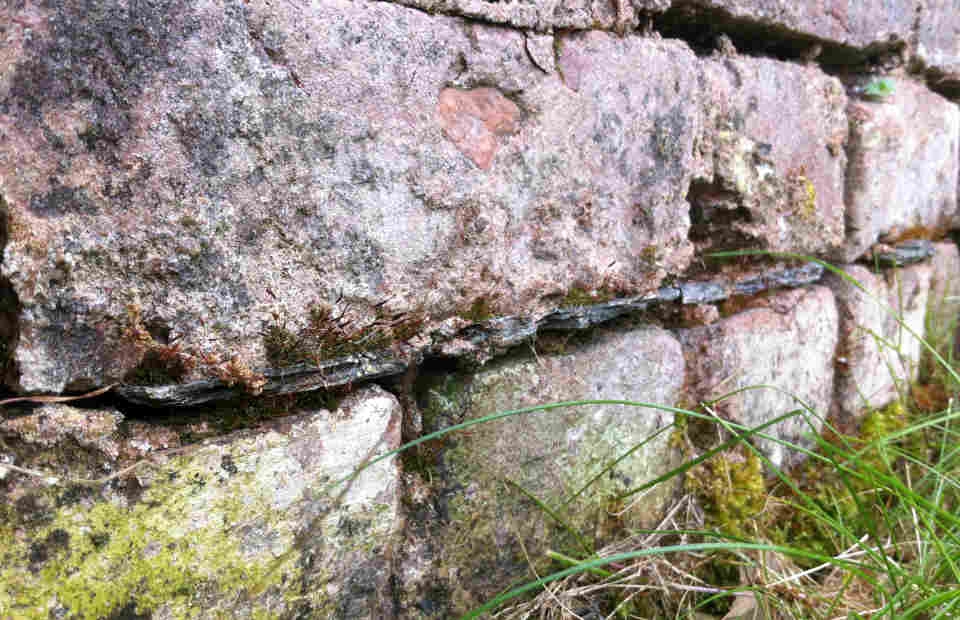
Traditional slate damp proof course. Photograph: Steve Wookey
Sometime the DPC can remain intact, but the DPC can be bridged. This is where the damp from the ground is able to travel up past the DPC because of a construction fault.
Examples of this include:
- Debris in the wall cavity or subfloor void.
- Internal or external renders / plasters overlapping the DPC
- External ground levels being raised above the DPC.
- Inappropriate insulation material in the cavity.
- Solid floors
- Intersecting masonry structures / abutting garden walls.
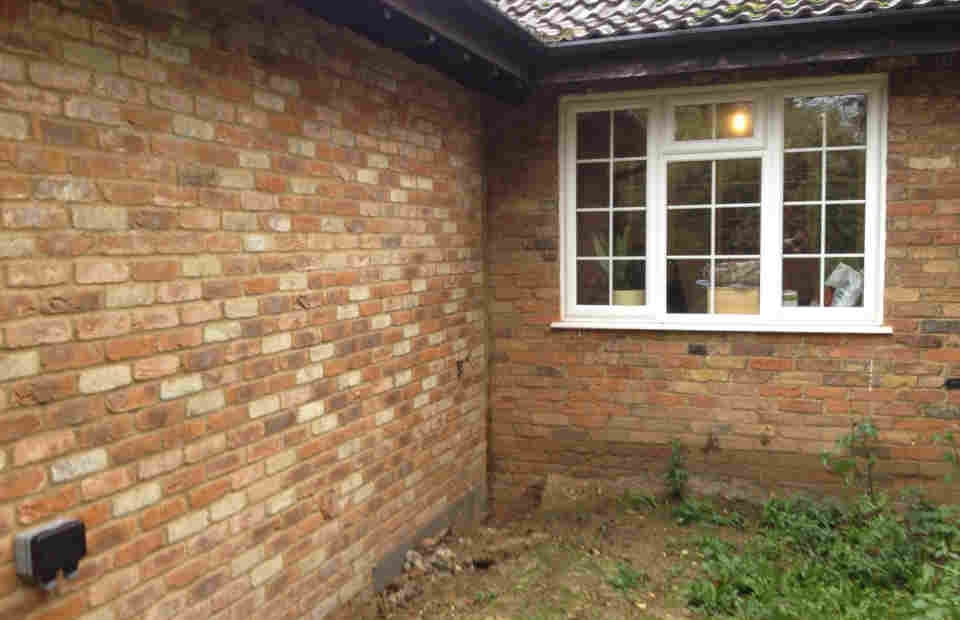
High external ground levels causing rising damp on the window wall. The wall to the left has had the earth removed to a lower level. Photograph: Steve Wookey
Is Rising Damp a Myth?
At this point it's worth addressing the debate around whether rising damp exists or not. There is a long-standing debate, both online and off, where people question if rising damp is real. The main reason that this debate continues to rage is the all-too-common misdiagnosis of rising damp.
There are inexperienced and underqualified surveyors and tradesmen out there that incorrectly diagnose rising damp. When the diagnosis is wrong, it means that the treatment fails and the 'damp' issue remains.
Misdiagnosis of Rising Damp
Rising damp is often confused with damp caused by condensation - this is one of the most common reasons for misdiagnosis. The PCA offer good advice around this in their Code of Practice for the Investigation and Control of Dampness in Buildings referring to BS5250: 2011 that states: ‘One of the most reliable ways that may be used to differentiate between dampness due to condensate and due to rising damp is to compare moisture in the contents of samples of masonry, or preferably mortar, from within the depth of the wall and near the inner surface of the wall; samples from within the wall will not be damp if surface condensation is the sole cause.’
In some other cases, there is a correct diagnosis of rising damp but the contractor fails to treat it. In most cases, this involves a failure to successfully inject a chemical DPC cream. Unsurprisingly, the incorrectly installed chemical DPC doesn't work. With both of these situations, you end up with a dissatisfied and often angry customer, and an industry that suffers.
The truth is that rising damp does exist and it does affect some houses. It is a genuine and serious problem that requires fixing with care and attention by qualified professionals. Hopefully, our guide will help with this.
Rising Damp - Internal Walls
Most people first notice an issue with rising damp on internal walls. Rising damp often results in tide marks on your internal walls up to the height where the water has reached. In most cases, these tide mark stains appear up to a metre above the skirting board. In some very rare cases, water can travel beyond this point.
The height the water reaches depends on several key factors. These include the pore structure of the bricks and mortar and the rate of evaporation. Masonry containing a high proportion of fine pores will allow the water to rise higher than one with less pores. Rising damp can occur up to 1.5 metres and even higher in some very rare instances.
The water from the ground often contains salts that are then deposited on the wall when the water evaporates. These salts can cause the paint to bubble and a white fluffy deposit to be left on the surface. There are two main types of salt - sulphates which result in crusty white patches and invisible hygroscopic salts known as nitrates and chlorides. The hygroscopic salts continue to draw moisture and therefore must be treated. Read more about treating salts on walls in our guide.
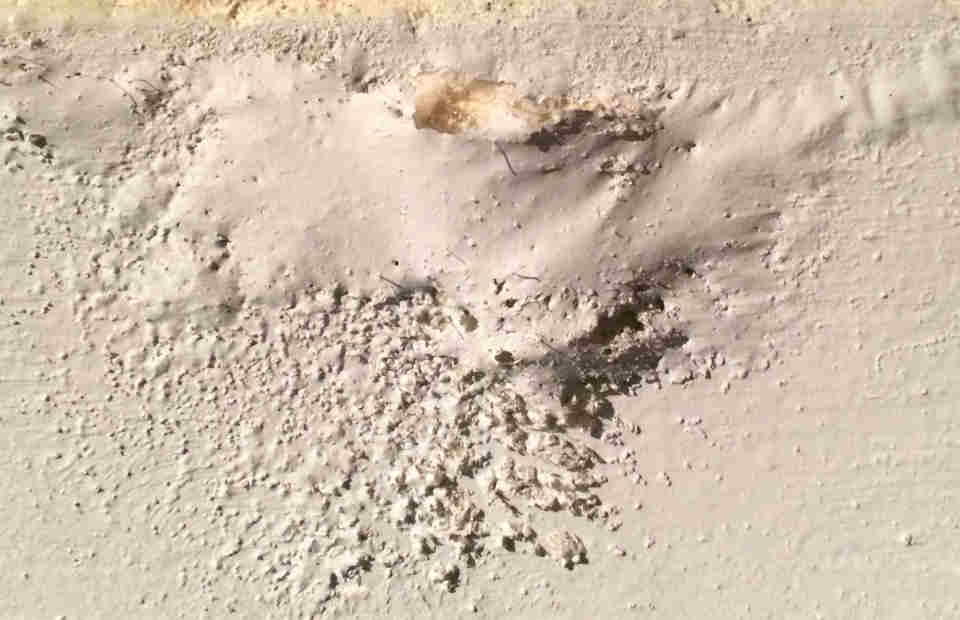
Salts debonding the paint work - if you look at the top of the bubble you will see the white fluffy salt deposit. Photograph: Steve Wookey
What causes rising damp in internal walls?
Rising damp in internal walls is caused by the same movement of ground water up through the brickwork by capillary action. It is the result of a failed or non-existant DPC or when the DPC has been bridged.
Rising Damp External Walls
Rising damp can affect both internal and external walls. When looking for evidence of rising damp on external walls, again you should keep an eye out for tide marks. You may also see some of the mortar crumbling between the bricks or stonework and salt deposits too.
Signs of Rising Damp
Rising damp is a relatively rare form of damp and treatment will only work if it is correctly diagnosed. It is therefore vitally important to get a professional diagnosis from a qualified surveyor – this will involve a rising damp survey of your home including analysis of the salts.
It can be hard to distinguish rising damp from other forms of damp like condensation or penetrating damp.
Having said that, the following are some of the more common signs of rising damp that you can look out for:
- Tide marks of salts
- Dark patches on walls that can be damp to touch - for a better indication of rising damp you want to determine that the brickwork / masonry is actually wet and not just the plaster or wallpaper.
- Staining of wall coverings, peeling wallpaper & blistering paint.
- Damp and musty smell.
- Discolouration & fragmenting plaster.
- Decaying timber e.g. skirting boards, floor boards, floor joists.
For more information on damp on external walls, read our guide.
What does rising damp look like?
Rising damp is often characterised by the tide marks on your wall above the skirting as well as powdery white salt deposits. It can cause plaster to bubble and wallpaper to peel away.
Rising Damp Images
The following rising damp images give you an idea of the visual appearance of the signs of rising damp:
Photographs of Rising Damp on Internal Wall
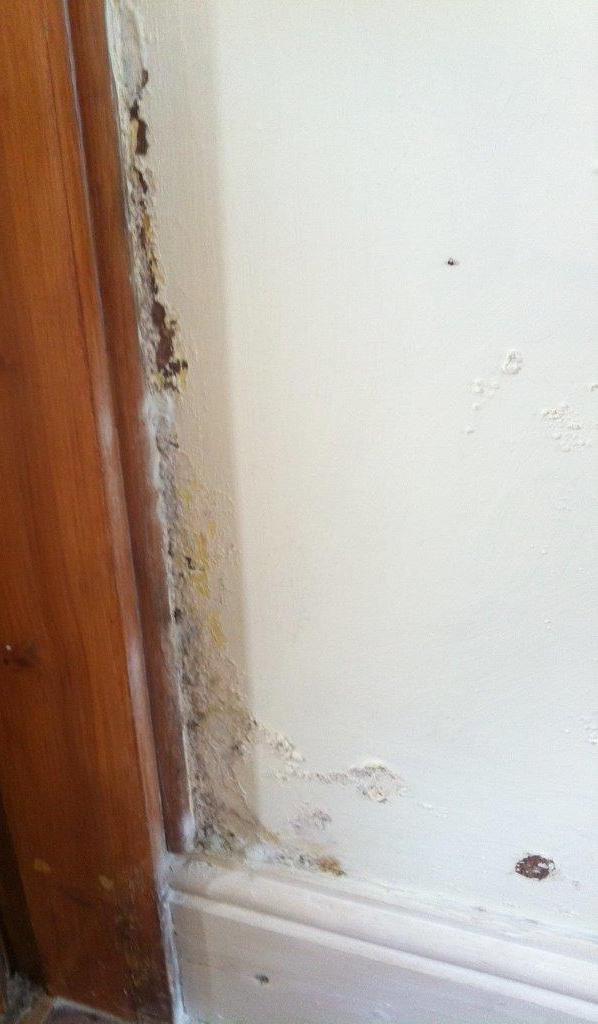
Photograph: Steve Wookey
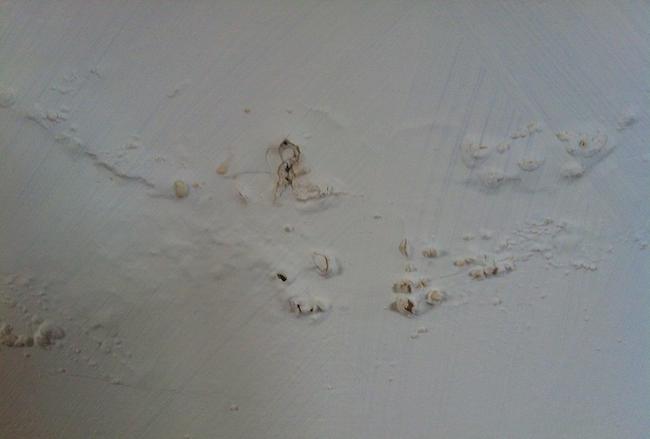
Photograph: Steve Wookey
Damage to Paint and Plaster due to Rising Damp
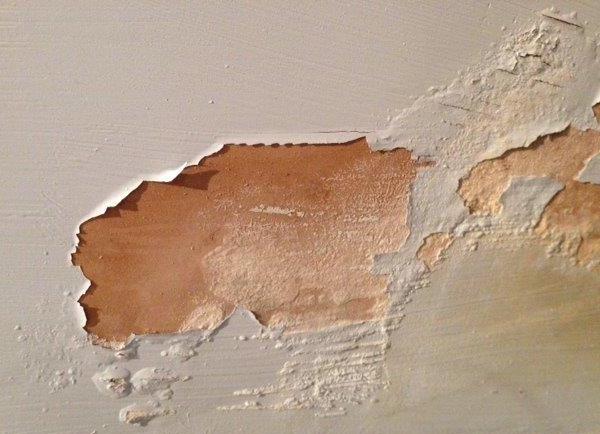
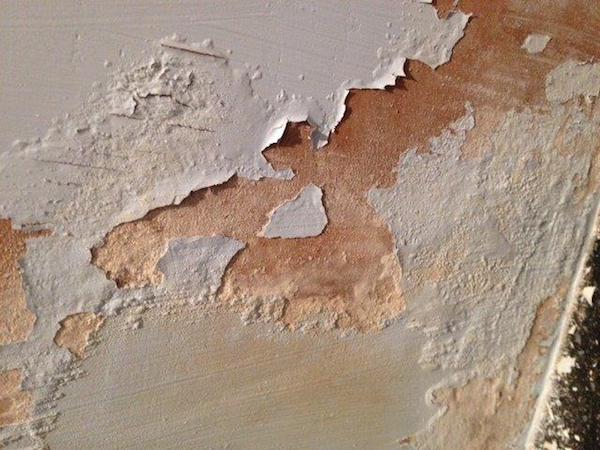
Photographs: Steve Wookey
What does rising damp smell like?
It is hard to distinguish the smell of rising damp from other forms of damp in that it’s a damp and musty smell.
Is rising damp a serious problem?
Rising damp can be a serious problem, as if left untreated it can lead to structural issues. The damage it can cause to your plaster, flooring and decorative finishes as well as the smell also makes it very unpleasant to live with. As with most forms of damp, rising damp is not good for your health, making some respiratory conditions much worse. It can also result in increased heat loss, leading to higher energy bills.
Buying a House with Rising Damp
If you are in the process of buying a house and a survey carried out by a RICS-approved surveyor suggests that you may have an issue with rising damp, you should investigate further. We would recommend getting a professional damp company to carry out a rising damp survey before completing on the property.
You will want to get a qualified surveyor ideally with industry-recognised professional qualifications. If your property was built after the 1850s, you would expect to find some form of DPC whether it be bitumen or slate. It is rare that this will have deteriorated unless there has been some subsidence which is a very serious issue in itself. Another potential reason the DPC has failed is that it has been bridged, usually by debris or insulation in the cavity wall that exists below the DPC level. The ground levels outside could have also risen above the DPC level.
Renting a House with Rising Damp
If you suspect that your rental property has a problem with rising damp notify your landlord or letting agent immediately.
Rising Damp Treatment
The most effective and economical way to treat rising damp is with a damp proofing injection cream. You can choose between complete kits or individual cartridges of PermaSEAL PRO DPC Injection Creams.
The cream is injected or hand-pumped into specially-positioned holes in the mortar course. Once inserted, the damp proofing cream reverts to a liquid. This allows it to penetrate the bricks and achieve complete absorption. As it cures, it creates a powerful water-repellent barrier and a new chemical DPC that stops water from rising up the wall. For full instructions on how to treat rising damp with damp proofing cream read our guide to injecting damp proof courses.
Alternatively, you can install a new damp proof membrane to act as a damp proof course. This is a much bigger and more complicated process that involves taking out each brick along the failed mortar course and installing a new physical damp proof membrane.
How to treat rising damp on internal walls
When you see evidence of rising damp on internal walls, you need to remove any wallpaper and plaster back to the bricks or substrate. You will also need to do this on the external wall of the property.
Check that the DPC has not been bridged in any way before proceeding with the injection of a new DPC. Treating rising damp on internal walls is all about carrying out the injection process as outlined above and then getting in a position to make good and redecorate internally.
The quickest way to do this is with a damp proof membrane.
How effective is a chemical DPC?
Chemical injections are highly effective at treating rising damp if installed correctly. The formulations have improved over the years and are now proven to provide long-lasting protection. PermaSEAL PRO DPC Injection Cream contains the highest concentration of active ingredients possible.
Re-Plastering after Treating Rising Damp
Once you have injected the new DPC, you will need to get the affected area re-plastered. The existing plasterwork is likely to contain hygroscopic salts that will continue to attract moisture unless fully removed. It is vitally important that you get the plasterer to re-plaster to a precise specification to prevent further issues with salt contamination.
For more details on the specification and step-by-step instructions read our guide to re-rendering after the insertion of a new DPC. In our guide, we take you through how a damp proof membrane can be used to speed up the process of making good after a new DPC.
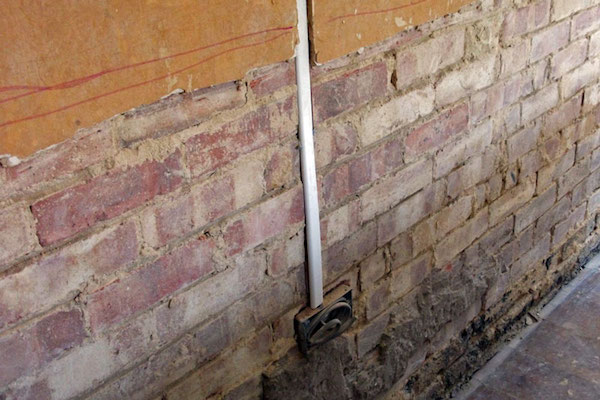
Plaster removed from a wall affected by rising damp. By Kebabknight [GFDL] or CC BY-SA 3.0 via Wikimedia Commons
Who treats rising damp?
If you believe your home or a property you own has an issue with rising damp, then you need to confirm your suspicions with a professional diagnosis. You should opt for a qualified damp surveyor, rising damp treatment specialist or preservation company that are experienced with rising damp injection treatment. The surveyor will carry out a rising damp survey, complete a thorough analysis and then recommend a treatment based on their findings. We suggest looking for certain qualifications when deciding who fixes your rising damp issue.
The surveyor should ideally have national industry-recognised professional qualifications:
Certificated Surveyor in Remedial Treatments (CSRT) - a qualification for surveyors in the remedial property industry. The qualification comprises three modules, including one on damp.
Certificated Surveyor in Structural Waterproofing (CSSW) - a qualification for those involved in diagnosing problems with water entering structures below ground level and who recommend design solutions.
If you live in a rented property then it is the landlord that is responsible for dealing with rising damp. They should get a professional to diagnose and treat the damp, being sure to rule out other forms of damp first.
Permagard – Rising Damp Specialists
Permagard has been supplying damp proofing cream for over two decades. Our years' of experience mean that we can discuss your issue and recommend the products that will provide the solution. You can also browse our rising damp treatments as well as our DPC membranes.
We are here to help so if you have any nagging questions or are unsure about any aspect of this rising damp guide then please contact us on 0117 982 3282 or [email protected]. Our technical team are always happy to help and make sure you get the right product for the job.


